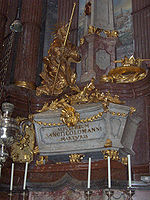Coloman of Stockerau
Saint Coloman of Stockerau | |
|---|---|
gibbet; tongs and rod; book and maniple | |
| Patronage | Austria; Melk; patron of hanged men, horned cattle, and horses; invoked against plague and for husbands by marriageable girls; invoked against hanging; invoked against gout[1] |
Coloman of Stockerau (
Life
Originally known as Colmán (variously rendered Koloman, Kálmán, Colman, and Colomannus), he was an Irish pilgrim en route to the
At the time of his death, there were continual skirmishes among Austria, Moravia, and Bohemia. Coloman spoke no German, so he could not give an understandable account of himself. He was hanged alongside several robbers.
According to Aidan Breen, "He was made a saint by the local people, possibly out of remorse for the deed and because of his endurance under torture and the many miracles reported from where his body was buried." (Breen, 2009)
Veneration

On 13 October 1014, his
A legend states that Coloman's body remained incorruptible for eighteen months, remaining undisturbed by birds and beasts. The
Eventually, the relics of Coloman were taken back from the Cathedral of
See also
References
- ^ Patron Saints for Chronic and Incurable Illnesses Archived 2013-02-12 at the Wayback Machine Retrieved 2012-03-04.
- ^ Monks of Ramsgate. "Colman". //Book of Saints, 1921. CatholicSaints.Info. 11 October 2012
 This article incorporates text from this source, which is in the public domain.
This article incorporates text from this source, which is in the public domain.
Sources
"Coleman", by Aidan Breen, Dictionary of Irish Biography, page 696, volume two, 2009.
External links
- Saint of the Day, October 13: Coloman of Stockerau at SaintPatrickDC.org
- Saint Coloman's Day
- Catholic Online: St. Coloman
- Saint Coloman of Stockerau at Saints.SQPN.com
- Coloman of Stockerau at Find a Grave
